-
90 results in Exploration of Musculoskeletal DiseasesSort byMost Viewed
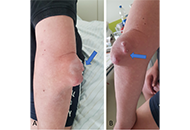 Similarities and differences between gouty arthritis and rheumatoid arthritis—an interesting case with a short look into the literatureOpen AccessCase ReportGout often presents as acute arthritis but may also present with chronic joint inflammation. For the diagnosis of an acute gout attack with its typical symptoms, the differentiation towards a bacter [...] Read more.David Kiefer ... Juergen BraunPublished: February 24, 2023 Explor Musculoskeletal Dis. 2023;1:11–19
Similarities and differences between gouty arthritis and rheumatoid arthritis—an interesting case with a short look into the literatureOpen AccessCase ReportGout often presents as acute arthritis but may also present with chronic joint inflammation. For the diagnosis of an acute gout attack with its typical symptoms, the differentiation towards a bacter [...] Read more.David Kiefer ... Juergen BraunPublished: February 24, 2023 Explor Musculoskeletal Dis. 2023;1:11–19
DOI: https://doi.org/10.37349/emd.2023.00003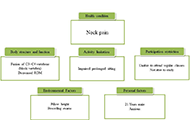 Physiotherapy management of a patient with neck pain having block vertebra: a case reportOpen AccessCase ReportCongenital fused/blocked vertebrae are an incidental finding in most cases. It remains asymptomatic unless there is a traumatic event or there is an increased biomechanical load which may be attribu [...] Read more.Sarah Quais, Ammar SuhailPublished: March 27, 2023 Explor Musculoskeletal Dis. 2023;1:31–36
Physiotherapy management of a patient with neck pain having block vertebra: a case reportOpen AccessCase ReportCongenital fused/blocked vertebrae are an incidental finding in most cases. It remains asymptomatic unless there is a traumatic event or there is an increased biomechanical load which may be attribu [...] Read more.Sarah Quais, Ammar SuhailPublished: March 27, 2023 Explor Musculoskeletal Dis. 2023;1:31–36
DOI: https://doi.org/10.37349/emd.2023.00006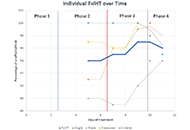 Return-to-play decision-making following ankle injury: a comprehensive case analysis of the functional hop testOpen AccessCase ReportFollowing anterior cruciate ligament (ACL) injury of the knee, the functional hop test (an averaging of 4 component hop tests including single-hop, triple-hop, cross-over-hop, and 6-meter-hop) is co [...] Read more.Michael Crinion ... Michael AgnonePublished: March 06, 2024 Explor Musculoskeletal Dis. 2024;2:75–81
Return-to-play decision-making following ankle injury: a comprehensive case analysis of the functional hop testOpen AccessCase ReportFollowing anterior cruciate ligament (ACL) injury of the knee, the functional hop test (an averaging of 4 component hop tests including single-hop, triple-hop, cross-over-hop, and 6-meter-hop) is co [...] Read more.Michael Crinion ... Michael AgnonePublished: March 06, 2024 Explor Musculoskeletal Dis. 2024;2:75–81
DOI: https://doi.org/10.37349/emd.2024.00036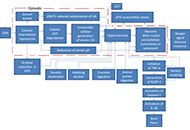 Premature mortality with gout and hyperuricemia may be reduced by early resolution of comorbid obstructive sleep apneaOpen AccessReviewHyperuricemia is known to be a necessary and causal condition for gout, but much more prevalent than gout. Medicine has standardized treatments for gout, but has no such determination for asymptomat [...] Read more.Burton AbramsPublished: August 31, 2023 Explor Musculoskeletal Dis. 2023;1:106–120
Premature mortality with gout and hyperuricemia may be reduced by early resolution of comorbid obstructive sleep apneaOpen AccessReviewHyperuricemia is known to be a necessary and causal condition for gout, but much more prevalent than gout. Medicine has standardized treatments for gout, but has no such determination for asymptomat [...] Read more.Burton AbramsPublished: August 31, 2023 Explor Musculoskeletal Dis. 2023;1:106–120
DOI: https://doi.org/10.37349/emd.2023.00015
This article belongs to the special issue Hyperuricemia current state and prospects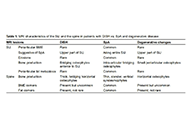 Is there a place for magnetic resonance imaging in diffuse idiopathic skeletal hyperostosis?Open AccessReviewDiffuse idiopathic skeletal hyperostosis (DISH) is a systemic condition characterized by the new bone formation and enthesopathies of the axial and peripheral skeleton. The diagnosis of DISH current [...] Read more.Iris EshedPublished: April 27, 2023 Explor Musculoskeletal Dis. 2023;1:43–53
Is there a place for magnetic resonance imaging in diffuse idiopathic skeletal hyperostosis?Open AccessReviewDiffuse idiopathic skeletal hyperostosis (DISH) is a systemic condition characterized by the new bone formation and enthesopathies of the axial and peripheral skeleton. The diagnosis of DISH current [...] Read more.Iris EshedPublished: April 27, 2023 Explor Musculoskeletal Dis. 2023;1:43–53
DOI: https://doi.org/10.37349/emd.2023.00008
This article belongs to the special issue Diffuse Idiopathic Skeletal Hyperostosis- A common but neglected disease Diffuse idiopathic skeletal hyperostosis, beyond the musculoskeletal systemOpen AccessReviewIt has been suggested that diffuse idiopathic skeletal hyperostosis (DISH), a skeletal disease characterized by the ligamentous ossification of the anterolateral spine, is a radiological entity with [...] Read more.Fabiola Atzeni ... Reuven MaderPublished: December 04, 2023 Explor Musculoskeletal Dis. 2023;1:216–227
Diffuse idiopathic skeletal hyperostosis, beyond the musculoskeletal systemOpen AccessReviewIt has been suggested that diffuse idiopathic skeletal hyperostosis (DISH), a skeletal disease characterized by the ligamentous ossification of the anterolateral spine, is a radiological entity with [...] Read more.Fabiola Atzeni ... Reuven MaderPublished: December 04, 2023 Explor Musculoskeletal Dis. 2023;1:216–227
DOI: https://doi.org/10.37349/emd.2023.00024
This article belongs to the special issue Diffuse Idiopathic Skeletal Hyperostosis- A common but neglected disease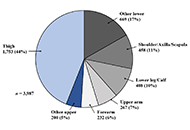 Soft tissue sarcoma: clinical recognition and approach to the loneliest cancerOpen AccessReviewSoft tissue sarcoma (STS) is a rare malignancy with a high incidence. Early diagnosis can reduce the rate of amputations and increase survival, however, this is typically delayed. The diagnosis and [...] Read more.Sujan Shakya ... Xiang ZhouPublished: February 06, 2024 Explor Musculoskeletal Dis. 2024;2:56–68
Soft tissue sarcoma: clinical recognition and approach to the loneliest cancerOpen AccessReviewSoft tissue sarcoma (STS) is a rare malignancy with a high incidence. Early diagnosis can reduce the rate of amputations and increase survival, however, this is typically delayed. The diagnosis and [...] Read more.Sujan Shakya ... Xiang ZhouPublished: February 06, 2024 Explor Musculoskeletal Dis. 2024;2:56–68
DOI: https://doi.org/10.37349/emd.2024.00034 Genetic basis for skeletal new bone formationOpen AccessReviewBone formation is a complex process that occurs throughout life, and is normally limited to the skeletal system. In bone formation, osteoprogenitor cells follow several developmental stages, includi [...] Read more.Bruna Parreira ... Jácome Bruges-ArmasPublished: October 23, 2023 Explor Musculoskeletal Dis. 2023;1:143–170
Genetic basis for skeletal new bone formationOpen AccessReviewBone formation is a complex process that occurs throughout life, and is normally limited to the skeletal system. In bone formation, osteoprogenitor cells follow several developmental stages, includi [...] Read more.Bruna Parreira ... Jácome Bruges-ArmasPublished: October 23, 2023 Explor Musculoskeletal Dis. 2023;1:143–170
DOI: https://doi.org/10.37349/emd.2023.00018
This article belongs to the special issue Diffuse Idiopathic Skeletal Hyperostosis- A common but neglected disease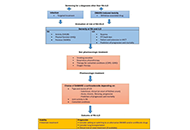 Interstitial lung disease in patients with rheumatoid arthritis: a narrative reviewOpen AccessReviewRheumatoid arthritis (RA) is a chronic immune-mediated inflammatory disease of unknown origin. Although it mainly affects joints, it can have extra-articular manifestations, with the lung being one [...] Read more.Gloria Candelas Rodríguez, Virginia VillaverdePublished: October 20, 2023 Explor Musculoskeletal Dis. 2023;1:128–142
Interstitial lung disease in patients with rheumatoid arthritis: a narrative reviewOpen AccessReviewRheumatoid arthritis (RA) is a chronic immune-mediated inflammatory disease of unknown origin. Although it mainly affects joints, it can have extra-articular manifestations, with the lung being one [...] Read more.Gloria Candelas Rodríguez, Virginia VillaverdePublished: October 20, 2023 Explor Musculoskeletal Dis. 2023;1:128–142
DOI: https://doi.org/10.37349/emd.2023.00017
This article belongs to the special issue Comorbidities in rheumatoid arthritis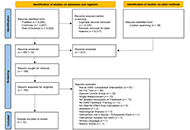 Role and effectiveness of surface EMG feedback in sports and orthopedic rehabilitation: a systematic reviewOpen AccessSystematic ReviewBackground: The aim of the study was to conduct a literature review within the fields of sports and orthopedic rehabilitation to evaluate the efficacy of interventions incorporating electromyogra [...] Read more.Thomas Haab ... Paul BurkeyPublished: September 12, 2024 Explor Musculoskeletal Dis. 2024;2:391–407
Role and effectiveness of surface EMG feedback in sports and orthopedic rehabilitation: a systematic reviewOpen AccessSystematic ReviewBackground: The aim of the study was to conduct a literature review within the fields of sports and orthopedic rehabilitation to evaluate the efficacy of interventions incorporating electromyogra [...] Read more.Thomas Haab ... Paul BurkeyPublished: September 12, 2024 Explor Musculoskeletal Dis. 2024;2:391–407
DOI: https://doi.org/10.37349/emd.2024.00065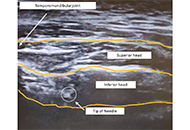 Participatory action ultrasound imaging in increasing clinician confidence with new approaches to trigger point dry needling of the lateral pterygoidOpen AccessCase ReportUpon self-reflection, some clinicians privately confess a lack of confidence in being able to safely perform trigger point dry needling (TrPDN) or trigger point injection (TrPI) on craniofacial musc [...] Read more.Andrew Ball ... Jordan SpennatoPublished: February 05, 2024 Explor Musculoskeletal Dis. 2024;2:49–55
Participatory action ultrasound imaging in increasing clinician confidence with new approaches to trigger point dry needling of the lateral pterygoidOpen AccessCase ReportUpon self-reflection, some clinicians privately confess a lack of confidence in being able to safely perform trigger point dry needling (TrPDN) or trigger point injection (TrPI) on craniofacial musc [...] Read more.Andrew Ball ... Jordan SpennatoPublished: February 05, 2024 Explor Musculoskeletal Dis. 2024;2:49–55
DOI: https://doi.org/10.37349/emd.2024.00033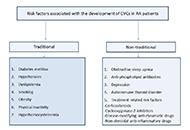 Rheumatoid arthritis and cardiovascular comorbiditiesOpen AccessReviewRheumatoid arthritis (RA) is the most common rheumatologic disease characterized by inflammation with a definite relationship with heart disease. Impaired immunity, chronic inflammation, genetic sus [...] Read more.Uğur Özkan ... Murat BirtanePublished: December 06, 2023 Explor Musculoskeletal Dis. 2023;1:264–288
Rheumatoid arthritis and cardiovascular comorbiditiesOpen AccessReviewRheumatoid arthritis (RA) is the most common rheumatologic disease characterized by inflammation with a definite relationship with heart disease. Impaired immunity, chronic inflammation, genetic sus [...] Read more.Uğur Özkan ... Murat BirtanePublished: December 06, 2023 Explor Musculoskeletal Dis. 2023;1:264–288
DOI: https://doi.org/10.37349/emd.2023.00028
This article belongs to the special issue Comorbidities in rheumatoid arthritis Empowering rheumatology through digital health technologies: contributions and barriersOpen AccessPerspectiveRheumatology, the medical specialty dealing with the diagnosis and treatment of rheumatic and musculoskeletal diseases (RMDs), is evolving with the emergence of digital health technologies, such as [...] Read more.Diego Benavent ... Antonio Gómez-CentenoPublished: April 9, 2024 Explor Musculoskeletal Dis. 2024;2:92–105
Empowering rheumatology through digital health technologies: contributions and barriersOpen AccessPerspectiveRheumatology, the medical specialty dealing with the diagnosis and treatment of rheumatic and musculoskeletal diseases (RMDs), is evolving with the emergence of digital health technologies, such as [...] Read more.Diego Benavent ... Antonio Gómez-CentenoPublished: April 9, 2024 Explor Musculoskeletal Dis. 2024;2:92–105
DOI: https://doi.org/10.37349/emd.2024.00038
This article belongs to the special issue Digital health technologies in rheumatology: emerging evidence and innovation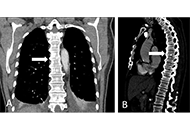 Diffuse idiopathic skeletal hyperostosis and axial spondyloarthritis—similarities and differencesOpen AccessReviewDiffuse idiopathic skeletal hyperostosis (DISH) and axial spondyloarthritis (axSpA) are diseases with inflammatory involvement of the axial skeleton that can result in new bone formation that may le [...] Read more.David Kiefer ... Xenofon BaraliakosPublished: November 20, 2023 Explor Musculoskeletal Dis. 2023;1:194–206
Diffuse idiopathic skeletal hyperostosis and axial spondyloarthritis—similarities and differencesOpen AccessReviewDiffuse idiopathic skeletal hyperostosis (DISH) and axial spondyloarthritis (axSpA) are diseases with inflammatory involvement of the axial skeleton that can result in new bone formation that may le [...] Read more.David Kiefer ... Xenofon BaraliakosPublished: November 20, 2023 Explor Musculoskeletal Dis. 2023;1:194–206
DOI: https://doi.org/10.37349/emd.2023.00022
This article belongs to the special issue Diffuse Idiopathic Skeletal Hyperostosis- A common but neglected disease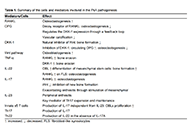 Psoriasis, bone and bowel: a comprehensive review and new insightsOpen AccessReviewPsoriasis is a chronic immune-mediated disorder affecting about 2% of the population worldwide which is associated with significant morbidity. The disease usually presents as raised, well-demarcated [...] Read more.Fakhreddin SaboonihaPublished: January 18, 2024 Explor Musculoskeletal Dis. 2024;2:1–19
Psoriasis, bone and bowel: a comprehensive review and new insightsOpen AccessReviewPsoriasis is a chronic immune-mediated disorder affecting about 2% of the population worldwide which is associated with significant morbidity. The disease usually presents as raised, well-demarcated [...] Read more.Fakhreddin SaboonihaPublished: January 18, 2024 Explor Musculoskeletal Dis. 2024;2:1–19
DOI: https://doi.org/10.37349/emd.2024.00029
This article belongs to the special issue Psoriatic disease: from the skin to the musculoskeletal system and beyond Utility of dimethylsulfoxide to preserve synovial fluid samples for microcrystal detection and identificationOpen AccessOriginal ArticleAims: To study whether the addition of dimethylsulfoxide (DMSO) to synovial fluid (SF) samples could be helpful to store frozen samples to improve the rates of detection and identification of cry [...] Read more.Fernando Pérez-Ruiz ... Juan J. Mateos-MazónPublished: February 21, 2023 Explor Musculoskeletal Dis. 2023;1:4–10
Utility of dimethylsulfoxide to preserve synovial fluid samples for microcrystal detection and identificationOpen AccessOriginal ArticleAims: To study whether the addition of dimethylsulfoxide (DMSO) to synovial fluid (SF) samples could be helpful to store frozen samples to improve the rates of detection and identification of cry [...] Read more.Fernando Pérez-Ruiz ... Juan J. Mateos-MazónPublished: February 21, 2023 Explor Musculoskeletal Dis. 2023;1:4–10
DOI: https://doi.org/10.37349/emd.2023.00002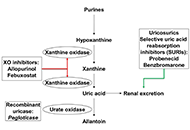 Safety and efficacy of gout treatments in people with renal impairmentOpen AccessReviewGout is common in people with chronic kidney disease and in general is sub-optimally managed. Lack of evidence due to the exclusion of people with chronic kidney disease from the majority of clinica [...] Read more.Hamish Farquhar ... Lisa K. StampPublished: September 02, 2024 Explor Musculoskeletal Dis. 2024;2:360–374
Safety and efficacy of gout treatments in people with renal impairmentOpen AccessReviewGout is common in people with chronic kidney disease and in general is sub-optimally managed. Lack of evidence due to the exclusion of people with chronic kidney disease from the majority of clinica [...] Read more.Hamish Farquhar ... Lisa K. StampPublished: September 02, 2024 Explor Musculoskeletal Dis. 2024;2:360–374
DOI: https://doi.org/10.37349/emd.2024.00062
This article belongs to the special issue Pharmacological and Non-Pharmacological Management of Gout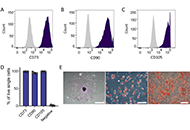 Mesenchymal stromal cells from people with osteoporosis are fewer, and defective in both osteogenic and adipogenic capacityOpen AccessOriginal ArticleAim: Osteoporosis (OP) is caused by imbalanced bone remodelling homeostasis. It is highly prevalent, especially in post-menopausal women, resulting in high risk of fracture and morbidity. Mesench [...] Read more.Féaron C. Cassidy ... Cynthia M. ColemanPublished: June 03, 2024 Explor Musculoskeletal Dis. 2024;2:164–180
Mesenchymal stromal cells from people with osteoporosis are fewer, and defective in both osteogenic and adipogenic capacityOpen AccessOriginal ArticleAim: Osteoporosis (OP) is caused by imbalanced bone remodelling homeostasis. It is highly prevalent, especially in post-menopausal women, resulting in high risk of fracture and morbidity. Mesench [...] Read more.Féaron C. Cassidy ... Cynthia M. ColemanPublished: June 03, 2024 Explor Musculoskeletal Dis. 2024;2:164–180
DOI: https://doi.org/10.37349/emd.2024.00046
This article belongs to the special issue Cell Therapy and Tissue Engineering for Musculoskeletal Conditions: From Pre-clinical Studies to Clinical Trials How should we do in the selection and follow-up of systemic conventional treatments in psoriasis?Open AccessReviewThere is an increasing need for appropriate effective treatment and long-term disease control in patients with psoriasis because of the decreased quality of life, increased physicosocial deficits an [...] Read more.Sevgi AkarsuPublished: December 05, 2023 Explor Musculoskeletal Dis. 2023;1:241–256
How should we do in the selection and follow-up of systemic conventional treatments in psoriasis?Open AccessReviewThere is an increasing need for appropriate effective treatment and long-term disease control in patients with psoriasis because of the decreased quality of life, increased physicosocial deficits an [...] Read more.Sevgi AkarsuPublished: December 05, 2023 Explor Musculoskeletal Dis. 2023;1:241–256
DOI: https://doi.org/10.37349/emd.2023.00026
This article belongs to the special issue Psoriatic disease: from the skin to the musculoskeletal system and beyond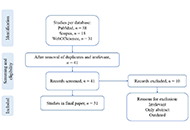 Scoping review on remote disease monitoring in rheumatoid arthritis: does it actually help the patient?Open AccessReviewRemote monitoring technologies (RMTs) are an emerging tool for assessing, monitoring, and following up on patients with chronic diseases including autoimmune rheumatic diseases (AIRDs). The best use [...] Read more.Prakashini Mruthyunjaya ... Debashish DandaPublished: January 22, 2024 Explor Musculoskeletal Dis. 2024;2:20–30
Scoping review on remote disease monitoring in rheumatoid arthritis: does it actually help the patient?Open AccessReviewRemote monitoring technologies (RMTs) are an emerging tool for assessing, monitoring, and following up on patients with chronic diseases including autoimmune rheumatic diseases (AIRDs). The best use [...] Read more.Prakashini Mruthyunjaya ... Debashish DandaPublished: January 22, 2024 Explor Musculoskeletal Dis. 2024;2:20–30
DOI: https://doi.org/10.37349/emd.2024.00030
This article belongs to the special issue Digital health technologies in rheumatology: emerging evidence and innovation -
